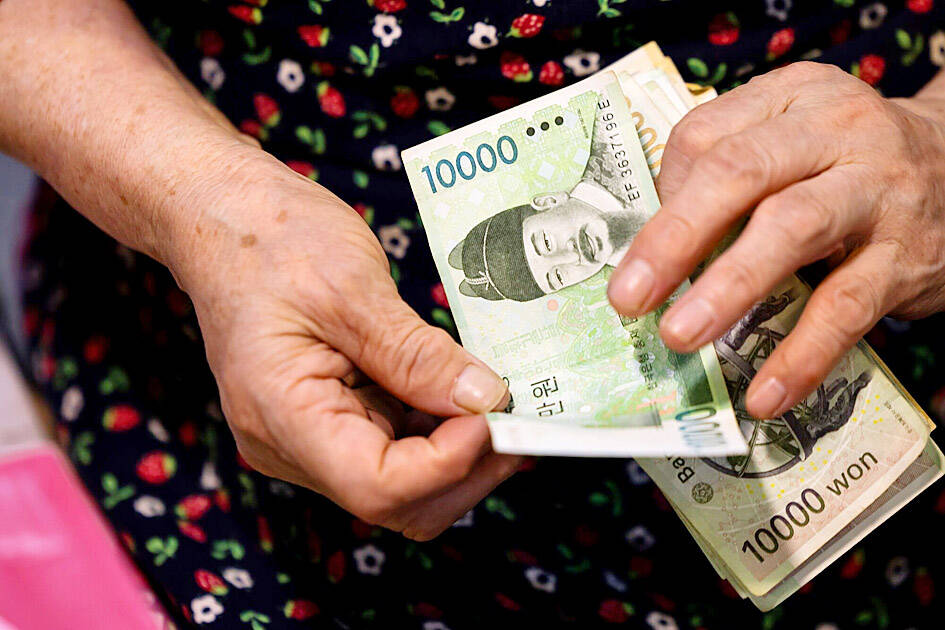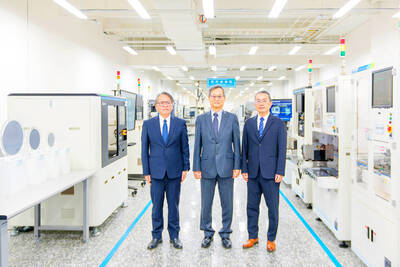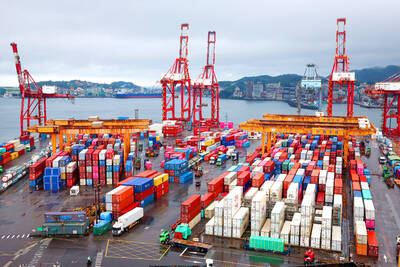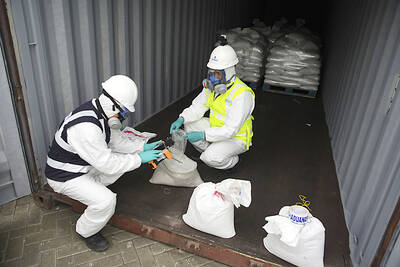Hedge funds are ramping up bets in the options market that the won will mirror the New Taiwan dollar’s recent rally against the greenback.
US dollar-won option trading volume spiked to this year’s high last week, according to the Depository Trust & Clearing Corp’s (DTCC) data, as speculation grew that South Korea and the US discussed the won’s direction in their currency talks.
Barclays Bank PLC said there has been increased demand for put options from hedge funds.

Photo: Bloomberg
A surge in the NT dollar this month has reshaped market expectations for Asian currencies. Earlier yesterday, an index of Asian currencies climbed toward the highest level since October last year, as US President Donald Trump’s tariff threats and the risk of a widening US fiscal deficit diminish the appeal of the US dollar.
Investors see the won as a likely candidate for comparable gains, as South Korea’s trade surplus with the US adds pressure on Seoul to tolerate a stronger currency. The US last year placed South Korea on its foreign-exchange monitoring list — which already included Taiwan.
Demand for US dollar-won put options with notional sizes over US$60 million outpaced call options on DTCC by a 3:2 ratio on Wednesday last week, underscoring the bias for bearish bets on the pair. The premium to hedge US dollar-won downside over the next month compared with the upside, as measured by risk reversals, traded near a 21-year high last week.
The tariff talks between the US and its trading partners have raised speculation that the Trump administration is open to a weaker greenback. For many, the won is becoming a favored proxy for broader shifts in US-Asia trade dynamics and a key hedge against declining US dollar strength.
The NT dollar’s 7 percent surge against the US dollar this month has raised hedging costs for Taiwanese insurers, who are large holders of US-dollar assets.
That is making the won a major proxy for hedging, Bank of America Global Research said in a note on Wednesday last week.
The Taiwanese currency traded at NT$29.953 per US dollar at the close in Taipei trading yesterday, down 0.06 percent from Monday.
The NT dollar appreciated beyond the psychological NT$30 per US dollar level with minimal resistance, said Wee Khoon Chong (張偉勤), a senior Asia Pacific market strategist at BNY Mellon Corp in Hong Kong.
The move was “driven mainly by weakening US dollar pressure as well as reported increasing hedging demand by domestic lifers,” he said.
The Taiwanese central bank’s comment last week that authorities are not defending any particular level for the exchange rate has made room for further gains in the local currency.
“Thirty is not a line in the sand, especially with the trend of dollar declines,” Chong said.

SMART MANUFACTURING: The company aims to have its production close to the market end, but attracting investment is still a challenge, the firm’s president said Delta Electronics Inc (台達電) yesterday said its long-term global production plan would stay unchanged amid geopolitical and tariff policy uncertainties, citing its diversified global deployment. With operations in Taiwan, Thailand, China, India, Europe and the US, Delta follows a “produce at the market end” strategy and bases its production on customer demand, with major site plans unchanged, Delta president Simon Chang (張訓海) said on the sidelines of a company event yesterday. Thailand would remain Delta’s second headquarters, as stated in its first-quarter earnings conference, with its plant there adopting a full smart manufacturing system, Chang said. Thailand is the firm’s second-largest overseas

‘REMARKABLE SHOWING’: The economy likely grew 5 percent in the first half of the year, although it would likely taper off significantly, TIER economist Gordon Sun said The Taiwan Institute of Economic Research (TIER) yesterday raised Taiwan’s GDP growth forecast for this year to 3.02 percent, citing robust export-driven expansion in the first half that is likely to give way to a notable slowdown later in the year as the front-loading of global shipments fades. The revised projection marks an upward adjustment of 0.11 percentage points from April’s estimate, driven by a surge in exports and corporate inventory buildup ahead of possible US tariff hikes, TIER economist Gordon Sun (孫明德) told a news conference in Taipei. Taiwan’s economy likely grew more than 5 percent in the first six months

SUPPLY RESILIENCE: The extra expense would be worth it, as the US firm is diversifying chip sourcing to avert disruptions similar to the one during the pandemic, the CEO said Advanced Micro Devices Inc (AMD) chief executive officer Lisa Su (蘇姿丰) on Wednesday said that the chips her company gets from supplier Taiwan Semiconductor Manufacturing Co (TSMC, 台積電) would cost more when they are produced in TSMC’s Arizona facilities. Compared with similar parts from factories in Taiwan, the US chips would be “more than 5 percent, but less than 20 percent” in terms of higher costs, she said at an artificial intelligence (AI) event in Washington. AMD expects its first chips from TSMC’s Arizona facilities by the end of the year, Su said. The extra expense is worth it, because the company is

The seizure of one of the largest known mercury shipments in history, moving from mines in Mexico to illegal Amazon gold mining zones, exposes the wide use of the toxic metal in the rainforest, according to authorities. Peru’s customs agency, SUNAT, found 4 tonnes of illegal mercury in Lima’s port district of Callao, according to a report by the non-profit Environmental Investigations Agency (EIA). “This SUNAT intervention has prevented this chemical from having a serious impact on people’s health and the environment, as can be seen in several areas of the country devastated by the illegal use of mercury and illicit activities,”